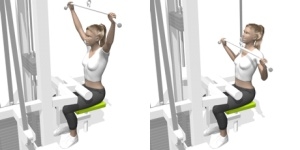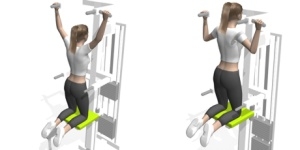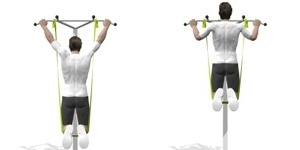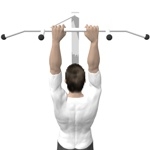Without doubt, pull-ups and chin-ups are one of the most effective basic exercises to develop a muscular upper body. They work a large number of muscles simultaneously and, through different grip setups and techniques, offer many different training variations.
Pull-up Benefits
| Strength | Pull-ups are a great exercise to strengthen almost all upper body and arm muscles, including the hand's gripping strength. |
|---|
| Muscles | Doing Pull-ups on a regular basis can develop an impressive upper body. |
|---|
| Balance | Pull-ups help maintaining the upper body's muscular balance by compensating the popular pressing exercise for chest and front shoulders. |
|---|
| Simplicity | Pull-ups require nothing but a fixed horizontal bar or something similar to grasp. Once you're able to perform a few pull-ups, you can train virtually anywhere. |
|---|
| Versatility | A variety of grip setups and many training techniques make pull-ups a versatile and interesting exercise. |
|---|
Basic Pull-up Instructions
- Stand below pull-up bar and grasp it with wide overhand grip. Hang on bar.
- Bend your knees and cross your lower legs.
- Pull your body up until your upper chest reaches the bar. Look up and keep chest up, leading toward the bar.
- Return with same speed. Keep the arms very slightly bent at the bottom of the motion to maintain the muscular activity. Simultaneously let your your shoulders be pulled up by the bodyweight.
- Repeat.
The Difference Between Pull-ups and Chin-ups
While the basic pulling movement is the same, pull-ups and chin-ups differ in the hand's grip setup.
| Pull-ups | Chin-ups |
|---|
|
|
| Palms facing away from you involves less arm flexor muscles and more back. It is harder. |
Palms facing you involves less back muscles and more arm flexors. It is easier. |
Pull-up Techniques
Especially for beginners pull-ups a are a major challenge. Not only do they require a good relation of strength and bodyweight, but also a very specific muscular coordination that can only be improved by doing it.
Don't stick to Lat Pull-downs for too long. Even if you're strong enough to sit and pull down about your bodyweight, it doesn't mean you're able to do a single correct pull-up, because you're not accustomed to the specific technique. Any great performance on the pull-up bar comes from hard and consistent training.
Beginner's Techniques
| Lat Pull-downs |
| - Introduction to the basic movement patterns of arm and shoulder joints.
- Adjustable training weight.
- Different grip attachments.
|
|---|
| Assisted Pull-ups, Machine |
| - Closely related to free pull-ups.
- Bodyweight is supported by training weight.
- Usually allows wide and neutral grip setup.
- Two separate handles allow an upright posture.
|
|---|
| Assisted Pull-ups, Elastic Band |
| - Free pull-up technique.
- Bodyweight is supported by an elastic band you either kneel or stand on.
- Adjustable training level by selecting from different elastic bands.
|
|---|
| Assisted Pull-ups, Training Partner |
| - Free pull-up technique.
- Requires a certain level of basic strength.
- Bodyweight is supported by the training partner, at least during the pull-up movement.
|
|---|
| Negative Pull-ups |
| - Free pull-up technique.
- Requires a certain level of basic strength.
- No external support.
- Grasp pull-up bar while standing on elevation and, as slowly as possible, perform only the negative movement.
|
|---|
| Partial Repetitions |
| - Free pull-up technique.
- Requires a certain level of basic strength.
- No external support
- Grasp pull-up bar and pull body about half way up.
|
|---|
Advanced Techniques
| Weighted Pull-ups |
| - If you can do 10 or more pull-ups, you may want to use a weight belt/chain to add some weight. Alternatively use a rucksack with weight plates (or books, ...) in it or hold a dumbbell between your feet.
|
|---|
| Slow Negatives |
| - Putting the emphasis on the negative part of the motion will activate a maximum number of muscle fibers.
- Pull you body up as usual and take about 4-5 seconds to return to the starting position.
|
|---|
Pull-up Variations
| Wide Overhand Grip |
| - Choose a more than shoulder-wide grip distance. You elbows should be bent about right-angled at top of motion. A too wide grip distance will limit the range of motion.
|
|---|
| Close Overhand Grip |
| - A shoulder-wide or even closer grip distance requires your arms to be bent almost completely, resulting in a higher demand of the arm muscles.
|
|---|
| Neutral Grip |
| - Usually the neutral grip is setup slightly wider than shoulder-wide apart. It allows a comfortable hand position and an even training of back and arms.
|
|---|
| Close Neutral Grip |
| - The close neutral grip distance trains more arms, less back.
|
|---|
| Reverse Grip |
| - As mentioned above, reverse grip pull-ups are also called chin-ups. They put more emphasis the arm flexors, less back.
|
|---|
| Wide Reverse Grip |
| - To involve more back when doing chin-ups, choose a wide reverse grip, provided your wrists tolerate this setup pain-free.
|
|---|
| Mixed Grip |
| - Mixed grip is a combination of neutral and overhand or underhand grip. Remember to train both sides evenly.
|
|---|
| One Arm Reverse Grip |
| - If you're strong enough, you can do one arm chin-ups. It requires an excellent relation of strength and bodyweight. Because of its high demand one arm chin-ups usually aren't part of a normal training routine.
|
|---|
Common Mistakes
- Straight Arms. Extending the arms completely disables all major muscular activity for a moment, which may result in overstressed passive structures, such as tendons and ligaments.
- Swinging. Try to keep hips and legs as stable as possible. Don't kick legs and don't swing back and forth.
Exercise Guide Links to Pull-ups & Chin-ups
Pull-up
Pull-up, Assisted
Pull-up, Behind Neck
Pull-up, Close Grip
[linkexercise]bodyweight_v_grip_pull_up[/linkexercise]
Chin-up
 « back
« back






















